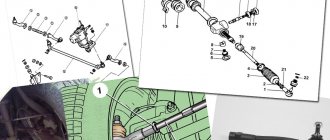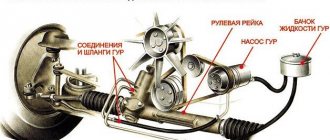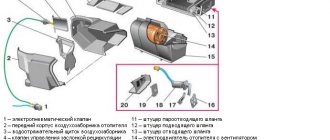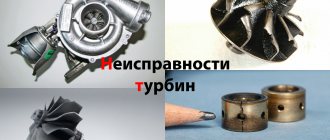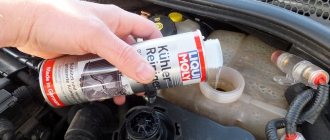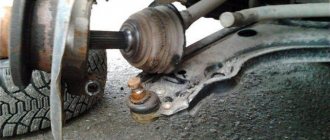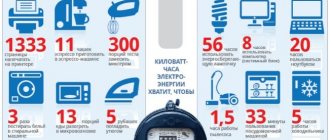Troubleshooting a steering rack: types of racks, signs of malfunctions, repairs, cost of work, features. Video about steering rack faults.
In most cars, steering turns are transmitted to the steering wheels using a special rack. And if such a device is also equipped with a hydraulic or electric booster, then the vehicle will be even more obedient.
But when driving on Russian roads, the quality of which in some places leaves much to be desired, this connecting shaft often experiences excessive loads and, as a result, breaks. How then can a motorist take the “reins of power” into his own hands - further in the review.
Types of steering racks
These units may differ significantly from each other in design if they are installed on different vehicles. Yet modern steering racks can be classified according to their operating principle:
- mechanical - such slats are driven by the steering wheel, which is turned by the driver;
- hydraulic – circulating oil helps the driver control them;
- electric - instead of oil, they are driven by current.
The first automobile steering racks were mechanical. Some budget vehicles are still equipped with such devices.
But still, most modern cars are equipped with hydraulic or electric power steering. The racks associated with different types of drives also differ in their operating characteristics.
In particular, an electric power-assisted rack , compared to hydraulics, requires less effort from the driver to control, but the electric power steering reacts painfully to water. Almost anything, it immediately “burns out”, and repairing a gearbox of this type is not cheap.
The power steering, in turn, allows the driver to better control the movement of the wheels than with an electric steering system. Maintaining power steering requires less investment, but it is important that the system of the steering rack and drive remains sealed.
Signs of a faulty steering rack
It's not that uncommon for a steering rack to break. Yes, and you can determine the malfunction associated with it yourself, without visiting a car service center. The main signs of problems with this device are:
- knocking in the front suspension, transmitted to the steering wheel;
- power steering pump is too loud;
- the steering wheel became less susceptible to rotation, in general or in some positions;
- swaying of the steering wheel when rotating, indicating “walking” of the rack;
- lubricant leakage in the area of the rack, while the steering wheel often begins to seriously resist and make noise when turning it;
- the car wobbles on the road or the steering wheel is difficult to return to place after a turn - there are probably problems with the rack settings.
This behavior of the car's steering complex indicates that the rack is not working as it should, and something needs to be done about it. Namely, remove it from the machine as soon as possible for diagnostics and troubleshooting, and thereby try to avoid costly repairs of the unit.
Steering wheels and listen: how to diagnose steering rack problems and what they entail
Our main focus today will be focused exclusively on the modern design of steering mechanisms for passenger cars - rack and pinion. And the hydraulic booster installed in quite a few of them simplifies control, but also complicates maintenance. Yes, yes, so much so that there are times when it is easier to replace the entire rack assembly than to have it repaired. It was with this task that a rather rare Jeep Patriot came to our lift. The SUV is indeed rare - but not in design: from a mechanical point of view, it can be used as a tool for building a car.
Briefly about the device
Before you start diagnosing the rack, it’s worth understanding how it works. Imagine two gears, one of which has been cut and turned into a straight belt with teeth. A shaft with a steering wheel was connected to the remaining round gear, and rods were connected to the tape, which were connected to the steering knuckles of the wheels. In fact, that's all - here you can stop the introduction to the base device. But let's be consistent.
Articles / Practice Car suspension silent blocks: how they are designed and how to change them Why do you need “rubber bands” in the suspension, how to understand that they are worn out and how difficult it is to change them? Today we will study a little theory and go to a car service to change the silent blocks of the front arms V... 62884 1 23 08/18/2016
The gear-rack pair is placed in a cylindrical housing. As mentioned above, steering rods are connected to a rack with teeth. These rods are covered with anthers, inside of which, of course, there is a lubricant to minimize the effects of friction. The tie rods are pivotally connected to the rack to reduce shock loads and create freedom of movement. The entire mechanism is attached to the body cross member in the engine compartment or, as in our case, to the front suspension subframe. In general, the steering mechanism is a living illustration of the axiom “the simpler, the more reliable.”
Yes, we didn’t mention one more “little thing” - these are the tie rod ends, which are a hinge with a rod welded to it. The tip is screwed onto the steering rod and secured with a lock nut. There are designs where the nut at the tip itself is split, and after screwing it is tightened with a bolt like a clamp. And the last question: why not make the steering rod one piece with the tip? Because thanks to the tip it is possible to adjust the toe-in of the front steered wheels. I unscrewed the tip - the toe increased, screwed it in deeper - it decreased.
Now let's say a few words about power steering. At the moment, there are two main types of amplifiers: hydraulic and electric. In hydraulic (power steering), the steering wheel is “helped” by pressurized fluid (most often transmission oil), which is created by a pump. The pump is driven by a belt from the crankshaft pulley or by an electric motor. In electric power steering (EPS), as you might guess, an electric motor comes to the aid of the driver. The amplifier should be considered as part of the steering mechanism, since the elements of the hydraulic amplifier are integrated into the body of this mechanism.
What can go wrong
Let's go from simple to complex. The destruction of the boot quite quickly renders the steering tip hinge unusable - fortunately, replacing the tip is not difficult. The procedure is quite simple and can be performed even at home. The only nuance associated with this that cannot be done at home is adjusting the angles of the steering wheels. Yes, no matter how the “garage and hammer” workers assure you of their professionalism, every time after replacing the tip it is necessary to check and adjust the wheel alignment angles. For not visiting the stand you will have to pay at least with uneven tire wear.
Articles / Practice Ball joints: how they are designed and how to change them How do ball joints work in a suspension? Why are they integrated into the suspension arms, why do they wear out and how difficult is it to change them on a modern car? Let's look into this issue in... 146190 3 17 08/03/2016
We have already talked above about the reliability of the rack and pinion steering mechanism - but everything cannot be absolutely good. There is still a weak link here – the anthers. They are made of soft polymer and can quickly become unusable due to rather unenviable working conditions. The further scheme is transparent and fast: the damage to the boot was not detected in time - and now dirt and dust began to enter the steering mechanism housing, the lubricant was no longer able to help - and all was lost.
The next element of the mechanism is the steering rods. The steering rod joint can “knock” even if the boot is intact, since it bears quite large impact loads.
Another unpleasant failure that can occur unexpectedly is teeth biting. In this case, the steering mechanism jams so that the steering wheel cannot be moved either to the left or to the right. The danger of such a malfunction while driving is unnecessary to describe, and its causes can be different - this is an insufficient amount of lubrication, and incorrect adjustment of the tension in the gearing, and simple wear.
This is where the possible problems with the steering mechanism end - we will look at power steering breakdowns in a separate article on rack repair in the near future. By the way, increased play in the steering wheel may also indicate that something is wrong with the rack. The design of the steering mechanism contains a stop, which, depending on the design imagination, can be adjustable or non-adjustable. So, if there is a possibility of adjustment, then by tightening the stop, you can adjust the backlash. If this is not possible, then the rack may have to be replaced or sent for repair.
How to diagnose problems
As in the case of suspension elements, one rule applies to the steering mechanism: if you go to a service station, check it yourself or ask a more experienced technician to check all the elements for breakdowns, defects or wear. If you are an infrequent visitor to services, then you should be especially careful in “looking out” for extraneous sounds when moving and turning the steering wheel. True, with this less accurate diagnostic method, the situation may ultimately turn out like the author of these lines.
The car came to us with a complaint that when starting to drive, a constant knocking sound was heard, similar to rolling balls. The first thing that came to the owner’s mind was saying goodbye to the wheel bearing, which was replaced on the same day. Later, when the knocking did not subside, he nevertheless sent the car for diagnostics, where they discovered a loose tie rod end - its joint was worn out. It’s good that the car was rear-wheel drive, and no one bothered to change the CV joint.
The conclusion from the above is quite simple: a steering fault can be determined while driving. The only exception can be a situation in which the wear has reached such a scale that the hinge or rod simply dangles. Therefore, I will repeat, but I will say: listen to your car!
Replacing the power steering mechanism assembly
The owner of the car is a rather responsible person, and therefore, at the first sign of a malfunction of the steering mechanism, he asked for help. The technician took the car for a test, during which it was discovered that the steering wheel was slightly biting when turning. Light biting could develop into jamming in the near future, so the decision was made to replace the rack assembly. And the owner simply did not have time to repair it, since the car is used every day.
Simplification in engineering and design is quite an interesting thing. This turned out to be the case in our case: the power unit, suspension elements and steering rack are partially attached to the subframe.
1 / 3
2 / 3
3 / 3
On the one hand, this is actually convenient for assembling a car on a conveyor belt, for vibration and sound insulation of the body and interior, and, in theory, it should have been convenient for removing and installing the steering mechanism. The only downside is that in factory repair manuals, operations for removing and installing anything mounted on a subframe are often limited to literally a dozen points, where the main ones are those that talk about removing the subframe assembly. The remaining two or three points are “Unscrew the fastening bolts. Remove the steering gear."
After some thought, our master decided to first go beyond the rules and dismantle the rack without removing the subframe, but only by lowering it on the fastening bolts. There is an idea, the goal is clear, and therefore - into battle!
Before starting work, we fixed the steering wheel strictly in the center. There are special devices and various methods for this. A simple method is to pass the seat belt through the steering wheel and fasten it in the buckle. The fixation of the steering wheel itself is extremely necessary: a slip ring and a steering angle sensor are installed inside the steering wheel. Both of them belong to the car’s passive safety system and are responsible, no less, for the operation of airbags and the exchange rate stability system. Violation of the settings of these sensors can lead to incorrect operation of the SRS system and/or directional stability, which will immediately appear in the constantly lit system indicator on the instrument panel. Well, improper operation of systems can cause an accident.
So, we pulled back the floor covering and unscrewed the connecting bolt between the steering column shaft and the steering gear shaft.
After that, having fixed the steering wheel, unscrewed the fastening nuts and removed the front wheels.
We then removed the nuts and disconnected the tie rod ends from both wheels.
Having finished with the rods, we disconnected the stabilizer links on both sides.
Then, very carefully, literally a few turns, we unscrewed the bolts securing the subframe to the car body.
1 / 3
2 / 3
3 / 3
As we remember, our steering mechanism is power-assisted, which means that the working fluid pipes are connected to its body.
Not without difficulty, we got to the connecting nuts and unscrewed them, disconnecting the tubes from the body.
The technician placed a container and collected the small amount of working fluid leaking from the system - it turned out to be not much, because we had previously pumped out the working fluid from the expansion tank of the power steering pump. Now nothing should get in the way of removing the steering rack.
But fate and the designers decreed otherwise. The trouble was that one of the bolts securing the rack to the subframe is located exactly under the power unit support bracket, and the second is located just under the exhaust pipe.
The regular head is not enough here, and the extended one does not fit because of the bracket. Thus, plans and hopes for bypassing the technological process specified by the manufacturer were ruined. The change in tactics was complicated by the fact that in order to unscrew the bolt securing the ill-fated support we had to not only sweat, but literally take a steam bath, like in a bathhouse - but we defeated him.
Next, we unscrewed the bolts securing the subframe to the body and very carefully lowered it to the height of open access to the mounting bolts. The levers were not disconnected from the subframe.
1 / 3
2 / 3
3 / 3
When the bolts were clearly visible, the master unscrewed them and exhaled with relief. The rail was removed and scrapped as planned.
A new rack took its place - pleasantly clean and guaranteed to work.
The installation of the steering mechanism in this case did not have any subtleties, so there is no need to describe it in detail: everything was simply installed in the reverse order.
1 / 3
2 / 3
3 / 3
The only important assembly nuance is the need to correctly install the steering gear shaft seal. Otherwise, dust and dirt from the street will seep into the interior.
After assembling and connecting all the power steering system pipes, we filled the pump expansion tank with fresh fluid and began the process of removing air from the system.
This process is as follows: with the engine running, you need to rotate the steering wheel from lock to lock and monitor when the liquid in the tank stops foaming, adding liquid if necessary. At the same time, the amplifier pump is very noisy due to the lack of fluid and the presence of air in the circuit, therefore such pumping cannot be carried out for a long time - the load on the pump is too high. Different manufacturers perform bleeding of the system in different ways: the only correct method for you should be specified in the repair manual. We will touch on this in more detail in the article on repairing a power rack.
Attention to details
Now, after studying the steering mechanism and virtually replacing the steering rack, it becomes finally clear how many nuances it contains, and how expensive its repair can be. We can repeat for the third time that you need to listen carefully to the car - but perhaps it’s better to say that you should be attentive to the little things. An extraneous sound, a loose steering tip, a cracked boot - all these minor defects can result in a lengthy service visit, and therefore it is worth spending time on them in advance.
Survey
Have you ever had to change your steering rack?
Your voice
Total votes:
Why do slats break?
Extraneous knocks in a car are unlikely to please its owner, even if they come from the steering rack. The cause of this “music” is mainly one of two problems:
- wear of the gear train or one of its constituent parts;
- play on the steering rack shaft at its connection with the bushing.
The gear train is perhaps the most stressed part of the steering rack. Therefore, the elements that form this connection can gradually collapse, fragmentarily or even entirely. A sign of such a process is the knocking noise heard when driving a car on an uneven road.
If the teeth become unusable, the element on which they are located should be replaced, and sometimes the entire steering rack. If there are no complaints about the clutch, but there is excessive freedom of movement of the rod, then an adjusting nut will help to put it in place. By rotating this part, you can set the desired gap between the contacting parts of the shaft and gear.
And yet, the main cause of knocking in the steering rack is the guide bushing, which is mainly made of plastic or bronze, but in both cases there is a risk of being worn out and, as a result, replaced. The destruction of this part occurs due to corrosion, moisture penetration, and also for other reasons.
In addition, as a result of long-term use or harsh operating conditions, the casing covering the rod can wear out significantly. So it ceases to be a serious obstacle to dust, dirt and moisture, which form an abrasive that causes a lot of trouble for the protected element. At the same time, contaminants manage to penetrate into the steering rack itself, destroying it.
Thus, rupture of the rack boot and oil leakage lead to wear of the steering rod or its ball end, which, in the event of a breakdown, are usually not repaired but replaced immediately.
What is steering play, its causes and elimination
Backlash is free movement at the connection of two or more car parts. Allowable backlash is the maximum displacement value that is not critical for the controlled element.
This phenomenon can occur in:
- steering;
- transmission cardan shafts;
- chassis elements;
- suspension units.
Let's look at the reasons for free play in the steering column. Then - how to eliminate it.
What is steering play
The steering column is the first unit in which increased free play may appear. Its main part is a rod, fixed on a shaft with hinges.
The connection of these elements is ensured by a gear transmission. Even from the factory there is a slight gap in it. It is necessary to ensure that the edges of the teeth do not wear out prematurely due to friction.
The driver can notice this phenomenon by turning the steering wheel left and right, so that the direction of the wheels does not change. During operation of the machine, the free play on the connections increases. Most often this occurs due to natural wear and tear of parts.
How the steering of a car works - watch the video review:
Lesson 37 General structure and principle of operation of the steering system
Signs of breakdown
Natural wear of gear joints and articulated drives occurs slowly, so it is difficult for the driver to notice at what point the backlash began to increase. To control this process, the motorist must periodically check this parameter. So, for passenger cars, the norm is when the free play of the steering wheel does not exceed 10 degrees.
When, while driving, the car slows down its response to turning the steering wheel, the driver needs to stop and check what the reason is. This is a clear sign of a breakdown.
Any squeaks, knocks, vibrations, or any deviation of the car from a given trajectory are all signs of a steering failure. Because of this, in an emergency situation, the driver may not be able to control the vehicle and cause an accident.
Permissible steering wheel play
Fearing this, some motorists generally try to eliminate the free play of the steering wheel. However, this will accelerate the wear of parts and they will need to be replaced with new ones more often than usual.
In the vehicle operation and repair manual, the manufacturer indicates the permitted steering play. If this data is missing, you should proceed from the basic requirements specified in the traffic rules.
The machine must meet the following requirements:
| Car type: | Maximum allowable backlash (in degrees) |
| Passenger car | 10 |
| Cargo | 25 |
| Bus | 20 |
As you can see, the larger the dimensions of the car, the higher the free play of the steering.
How to check steering play
You need to check the steering play as follows.
- Place the car on a hard, flat surface - concrete or asphalt surface. The wheels of the car are dry, clean and placed in the direction of the longitudinal axis of the body.
- Before taking measurements, the steering wheel is turned left and right to feel the moment when the wheels begin to change their direction.
- A device is installed on the steering wheel that shows the degree of deviation from the center point.
- The indicators for free turn left and right are summed up.
What tool is used to check
The easiest way to measure steering play is using a regular ruler. A mark is placed on the steering wheel. Then it is turned to the right, the scale of the ruler is placed against the mark, and one edge is pressed against the left post. When turning freely to the left, the mark will pass several divisions on the scale. It is worth noting that this method is not accurate for passing vehicle inspection.
Here is another way to determine the total backlash:
How to check steering play yourself
To accurately determine the amount of play, you need to purchase a play meter. There are two types of these devices: electronic and mechanical. The former are more accurate, can have multiple functions, and are very easy to use. The second category does not require batteries, and they are highly reliable.
Here's how the electronic model works:
How to check steering play with the ISL-M device
Possible causes of play and their diagnosis
In addition to the natural wear and tear of parts, the reason for the appearance of free play in the steering column is a consequence of a malfunction of the parts involved in driving the car. All breakdowns can be diagnosed in the following three ways.
Engine off
If increased free play is felt when the engine is off, the entire steering circuit must be checked. Here are the main problems that diagnostics can identify:
- the steering tips are worn out;
- breakage of the steering column shaft crosspiece;
- wear on the rack gear teeth;
- if the car is equipped with a steering gear (old cars in which it acts as a power steering), then play may appear in its mechanism;
- wear of the upper or lower ball joint.
When driving
If the steering wheel feels loose while driving, you need to pay attention to related problems.
- The car pulls to the side. The reason is an unadjusted wheel alignment.
- When turning the steering wheel, extraneous noise occurs. The reason is insufficient power steering fluid level.
- Knocking noise from the front end when driving on rough roads. The reason is the failure of steering rods and their tips. If this knocking sounds in the steering wheel, you need to check the steering rack.
- Steering wheel vibration. It occurs when the wheel rims are unbalanced. In addition, the cause of the steering wheel beating may be a breakdown of the ball joints or steering tips.
- Loss of smoothness. Turning the steering wheel jerkily indicates wear on the steering rack.
When braking
Free play of the steering wheel that occurs when braking may indicate the following problems:
- hub bearing failure. You can identify this damage by jacking up the car and shaking the wheel. If it is loose, then the problem is in the wheel bearing.
- after a recent repair, the chassis mechanics did not tighten the hub fastening properly;
- The steering mounting bolts are not tightened properly;
- wear of brake discs or pads.
Any changes in the car’s behavior on the road deserve the motorist’s close attention. Ignoring alarm signals is fraught not only with failure of parts, but also with the creation of an emergency situation.
How to eliminate backlash
In many cases, steering play can be eliminated by properly adjusting the vehicle's control system. It is worth checking the tightness of all mounting bolts, and also pay attention to the adjusting screws. How to remove steering play in difficult situations?
In the steering column
Cardan joints are attached to the steering shaft. There are two of them in standard columns. They are fixed with bolts. Another reason for free play in the steering column is wear in the sockets where these elements are installed.
To carry out repairs, you will need to put the car on an overpass or drive it into a garage with an inspection hole. When replacing the crosspiece, the steering wheel should be fixed. If after replacing the hinge the driver hears a rattling sound, it is necessary to tighten the mounting bolts.
Eliminating play in the steering gear (if the car has one) is done by adjusting the gap between the bipod shaft and the worm shaft.
Steering wheel
It is rare, but it happens that completely replacing all worn parts does not eliminate the increased free play. In this case, you should check the installation of the steering wheel itself. In some cars, the gear mount of this part fails due to poor-quality material from which it is made.
So, eliminating play in a car's control system is not just a matter of comfort. The safety of everyone in the car depends on the serviceability of its elements.
Here's another useful tip about steering tuning:
How to TIGHTEN the steering rack with power steering? Is it worth REPAIRING it? » Articles » What is steering play, its causes and elimination
Source: https://avtotachki.com/chto-takoe-lyuft-rulya-ego-prichiny-i-ustranenie/
Features of steering rack repair
If the steering rack is not electronic, requiring special settings, then it is quite possible to repair it yourself. However, taking into account the importance and rapid wear of this unit, it makes sense if it breaks down to contact a car service center. Or even replace it with a new one.
Due to the specific design, it is unlikely that it will be possible to repair the steering rack without disassembling, at least partially. Before the repair itself, it is advisable to carefully study the condition of the unit as a whole and the following components associated with it:
- ball and steering rods;
- wheel bearings;
- auxiliary drives.
Diagnostics of this kind will allow you to identify the location of the breakdown and facilitate repairs. Next, the steering rack or its elements are removed from the car, and the malfunction is directly eliminated.
Repair or install a new one
Although most parts of the steering rack must be immediately replaced when they fail, it itself is quite repairable, and in the event of a malfunction, it is not at all necessary to completely change it. However, it is quite difficult to give unambiguous advice on whether it is worth repairing this unit or whether it is better to immediately purchase a new one.
Of course, a new branded rail will work more reliably than a restored one, but its price will most likely significantly exceed the cost of repairs. Replacing this unit in case of problems is justified for premium cars. Car enthusiasts who are not strapped for cash can also take this step. Another compromise option is non-original devices or contract ones, but in good condition.
As for racks with electric power steering, when contacting them at a car service center, regardless of the complexity of the breakdown, a replacement device will most likely be offered. It’s just that few people want to tinker with such units.
The fact is that in case of malfunctions with the mechanics of racks equipped with UER, grinding the part cannot be done. And to set up electronics, diagnostics or soldering may be required, which often takes a lot of time and requires high skill of specialists.
Repair kit for rack
This kit usually includes various spare parts and consumables:
- protective covers;
- oil seals;
- bushings.
When repairing a steering rack, car enthusiasts use a similar “arsenal” quite often. However, the result obtained will depend, firstly, on the quality of the spare parts from the kit, and, secondly, on what will be done with them.
Those who want to qualitatively repair the steering rack at a reasonable price can purchase a repair kit themselves, and engage a car service for the necessary work, and at the same time receive a guarantee for the services provided. Or maybe for spare parts, depending on where they were bought.
Repair of rack with power steering
Most cars today are equipped with power steering racks. And if this “couple” suddenly starts tapping, then you should not immediately screw up the system. First, you can try to fix the problem using a soft method - adjusting the position of a special nut with a special wrench. However, it should be borne in mind that in this way the problem with extraneous noise coming from the unit can still be solved, but, for example, eliminating an oil leak is unlikely.
To carry out a full repair of a rack with power steering, a car enthusiast will need not only standard plumbing tools, but also some specific ones:
- octagonal key;
- bearing puller;
- pliers for removing and installing retaining rings.
But the rack will still have to be removed from the car. Therefore, you should prepare oil for the hydraulic booster and a complete set of consumables, such as oil seals, seals, and bushings. Access to the element being repaired is provided by installing the machine on a lift or inspection pit. The repair of the unit itself can be divided into four parts:
- removing the steering rack from the car;
- disassembling the rack;
- assessing the condition of parts and replacing faulty ones;
- installation of the steering rack on the car.
After dismantling the steering rack, it is recommended to clean its housing from dirt, and after disassembly, wash the components. Upon completion of the repair, the unit should still be adjusted, since unnecessary gaps can cause it a lot of trouble. At the same time, you should not ignore the previously mentioned control nut.
What if... there is play in the steering rods - autocentre.ua
There are details that are not to be joked about. But some drivers stubbornly ignore play in the steering - they say it won’t fall off while driving. It may not fall off, but problems with controllability are guaranteed.
| There are details that are not to be joked about. But some drivers stubbornly ignore play in the steering - they say it won’t fall off while driving. It may not fall off, but problems with controllability are guaranteed. |
| The more steering rods there are, the greater the total play when the joints wear out. |
Steering rods are designed to transmit the force that turns the steered wheels (usually the front ones) from the steering mechanism to the steering arms of the hubs. They are also part of the so-called steering linkage and at the same time ensure that the steered wheels rotate at different angles - after all, when turning, the wheels roll along different radii.
There are hinges at the ends of the steering rods. Thanks to them, during mutual movements of rods, wheels and body during suspension operation, the possibility of transmitting force from the steering mechanism remains possible and the angle of rotation of the wheels chosen by the driver remains unchanged. One or two rods usually have a threaded part to change the length of the rod, which is required when adjusting the wheel alignment angles (wheel toe angle). Cars with a rack and pinion steering mechanism (the majority of these today) have two rods and four lugs, while mechanisms such as worm-roller, screw-nut, etc. have three rods and six lugs.
Design
Ball joints are the most common type. They consist of a pin, the spherical part of which is placed in a dense “bed” (liner) inside a durable tip body. Often the role of a finger is played by the spherical end of the rod. The liner can be rubber, plastic or metal. To compensate for its wear, a spring is sometimes provided. The opposite (conical) end of the pin is tightly attached to the mating part - another rod, swing arm, bipod or steering rack, on which it is fixed with a nut with a locking insert or cotter pin. Such hinges provide large angles of mobility of interconnected rods.
Rubber-metal bushings are sometimes used with rack and pinion steering gears. They are simpler and consist of rubber and spacer bushings. These joints provide relatively limited freedom to the thrust, so they are usually used on internal tips where greater mobility is not required.
Types of faults
| The result of unskilled repairs is a “squeezed out” liner. | Damage to the boot can accelerate tip wear several times. |
| Rods bend primarily in structures where they are not protected by parts of the body and chassis. |
Wear of the joints is the most common malfunction of not only rods, but also the steering system as a whole. Usually the liner (or rubber bushing in some designs) is worn out or destroyed. For hinges with liners, after a long mileage the spherical surface of the pin may become worn. Its conical surface or thread at the end is damaged as a result of corrosion or improper installation/disassembly.
Rods rarely bend - due to a direct impact with a stone or a wheel hitting the edge of a hole.
If the cotter pin securing the castle nut is reused or installed incorrectly, it may fall out. As a result, the nut may spontaneously unscrew and the pin will fall out of the mating part, which will lead to a violation of the geometry of the steering linkage and loss of control over the car. For hinges with a collapsible design, spontaneous disassembly is possible after unqualified repairs - due to a retaining ring that has lost its elasticity, its incomplete seating, or excessive tension on the liner.
A subtle but significant malfunction is a rupture or displacement of the boot cover from the mounting socket. As a result, dust, dirt and moisture will enter the hinge, which will accelerate its wear. The toe angle adjustment mechanism - bushings, locknuts, threaded part of the rods - may suffer from corrosion and damage when in contact with obstacles on the road.
Signs of trouble
The first sign of wear on the steering rod joints is a large free play of the steering wheel and a knocking noise, noticeable when the steering wheel is rocked left and right. Significant wear of the tips or a “self-disassembled” joint manifests itself in the vehicle yawping along the road and inaccurate control. This does not lead to a complete loss of control, since the ball part of the pin, as a rule, does not fall out of the body. But due to the unscrewed fastening nut of the pin, the steered wheels can turn in different directions, and the car will no longer obey the steering wheel.
Service
| To extend the “life” of the hinges, some owners inject them through self-embedded oil nipples. | By rotating the threaded hinge cover, in outdated designs you can eliminate the backlash of the pin. |
Most modern steering rods of passenger cars are maintenance-free and cannot be repaired, so they must be replaced as they wear out. When selecting non-original units, it is necessary to take into account not only the dimensions of the pin cone, but also its spherical part. On heavy SUVs, the hinge design can be dismountable, so that the worn-out “filling” can be replaced. Often, on such cars, the hinges need to be periodically sprayed with grease.
There are also outdated designs that provide for adjustment of the pressure spring force - as the play in the hinges increases to compensate for the wear of the liners. Garage craftsmen undertake to sort out “disposable” hinges, but this is not worth doing - after all, not only the liner, but also the steel pin has its own service life and fatigue strength. If the “rated” service life is exceeded, it may break at the base of the ball.
Steering rack repair cost
So, if the steering rack breaks down, a car owner has several ways out of this situation. And the first of them is, of course, repairs, the quality of which, however, determines the potential mileage of the unit. You can also consider options for replacing the entire installation or some of its parts.
Different methods - different prices. The estimated cost of repairing the steering rack and the spare parts involved in this process will be:
- repair of the steering rack in a turnkey car service: 8-15 thousand rubles;
- repair of rack with electric power steering: from 15,000 rubles;
- steering rack repair kit: RUB 3,500–10,000;
- restored rack: 10-25 thousand rubles, together with the cost of car service services it turns out to be 13-30 thousand rubles;
- non-original rail: Chinese - from 12 thousand rubles, branded - up to 30-40 thousand rubles;
- original steering rack: from 50 thousand rubles.
Steering rack play is dangerous
We pay for photo reports on car repairs. Earnings from 10,000 rubles/month.
Write:
Faults in a car's steering rack can not only cause driving discomfort, but also cause more serious damage and even lead to an accident. Signs of a malfunction are: an increase in mechanical force when turning the steering wheel, the hum of the power steering pump, leaking power steering fluid, knocking while driving on rough roads, rusting of the rack shaft.
Signs of a faulty steering rack
Most cars are equipped with hydraulic booster (power steering) or electric power steering (EPS). The main faults of the steering rack are similar in them, but there are also differences, so it makes sense to consider them separately.
Power steering rack malfunctions
Symptoms of a faulty steering rack with power steering are often associated specifically with the hydraulic system - fluid and pump. So, if a hydraulic rack breaks down, the driver will feel:
- Increased effort when turning the steering wheel. In other words, the steering wheel becomes “heavy”, and if you could literally turn it with one finger, now you need to make significant efforts to turn it.
- Regular decrease in power steering fluid level in the expansion tank. This is indicated by a corresponding lamp on the dashboard, fluid leaks under the car or on elements of the engine compartment.
- Knock when driving. It is especially clearly expressed when driving on uneven roads.
- When turning the steering wheel, a strong hum is heard. And the more the steering wheel is turned (no matter in which direction), the louder the noise becomes. Often the hum is accompanied by a slight vibration of the steering wheel.
- After turning the steering wheel, it slowly or does not return to its original position.
- When the car moves straight, the front wheels do not maintain the trajectory, which is why the car “fidgets” along the road.
Electric steering rack malfunctions
In general, electric rack malfunctions are similar to hydraulic rack problems, except for fluid leaks. So, when a rack with an EUR fails, it often happens:
- knocking noise when turning the steering wheel;
- biting the steering wheel;
- uneven force on the steering wheel;
- spontaneous rotation of the steering wheel;
- The red steering wheel icon is lit on the instrument panel.
In general, electric rack malfunctions are similar to hydraulic rack problems, but they are caused by slightly different reasons, which will be discussed below. the problem in this case is water that gets onto the rod or into the rack control unit.
Causes of steering rack malfunction
There are three main reasons why you may hear a knock in the steering rack. This is wear of the worm pair (distributor), wear of the toothed part of the shaft, wear of the shaft along the bushing.
Thus, the most loaded unit in its design is the clutch between the gear and the gear base. Accordingly, the teeth here may collapse over time - partially or even completely. This can be understood by the knocking sound when holding the steering wheel while driving over uneven surfaces.
If there is no wear on the teeth but slight play on the rod, the situation can be corrected using an adjusting nut. By tightening it, you will establish the optimal distance between the teeth of the rack and pinion. If the teeth are completely broken, then such a rack must be replaced (sometimes only the gear can be replaced).
When a hole has formed in the bushing. Due to corrosion, due to the ingress of moisture, an abrasive appears inside, which eats the bushing (can be plastic or bronze). The malfunction is eliminated by replacement from a special repair kit.
Another cause of failure is wear of the tie rod end or the entire tie rod. This happens due to the rupture of the boot and washout of the lubricant. Usually these parts cannot be repaired, and accordingly, they are replaced with new ones. Same with the ball end.
The thrust is located in the anther, which over time or under the influence of external factors can lose its integrity. Accordingly, dust, dirt, and water get into it, which plays the role of an abrasive. When moving, the abrasive significantly wears out the rod and dirt gets into the rail, breaking it.
If the car “fidgets” on the road or the steering wheel does not return well to its original position, it means that the steering rack is poorly adjusted (although other options are possible, so additional diagnostics are needed).
Next, we will consider the main reasons why the power steering rack (hydraulic and electric steering rack) fails.
Why does the power steering rack malfunction?
Reasons why steering rack and power steering malfunctions occur:
- Shaft rusting . Modern manufacturers do not always make the steering rack drive shaft from high-quality metal, and certainly do not apply a large anti-corrosion layer to it. For this reason, rusting of the shaft housing, which “walks” along the seals, often occurs. Because of this, the thickness of the shaft decreases and power steering fluid may leak with all the ensuing consequences. It often rusts after the car has been parked for a long time, for example, in the autumn-winter period.
- Wear of rubber seals of the power steering system . This applies both directly to the oil seals and seals in the rack, and to connections located in other parts of the system, for example, in the area of the expansion tank. Over time or under the influence of mechanical reasons (tanning, overheating), rubber products lose their properties, which is why they can leak liquid, and, accordingly, its level in the system will decrease.
- Partial failure of the power steering pump . This usually happens for natural reasons (wear) or when using low-quality power steering fluid. In particular, the power steering pump wears out greatly with frequent significant turns of the wheels, especially in a situation where the car with the wheels turned out is left in this position for a long time.
- Malfunction of distributor valves . This leads to improper movement of fluid through the system, and, accordingly, to the operation of the amplifier.
- Damage to the hydraulic cylinder piston system . Because of this, the necessary pressure will not be created in the system.
- Loose or broken pump drive belt . If the belt breaks completely, then the pump will not work; this failure is critical. However, often the belt simply stretches (wears out) over time, so it can slip on the pulleys, which is why it does not transmit to the pump the angular velocity necessary for normal operation. Accordingly, the pump will not create the necessary pressure in the system.

